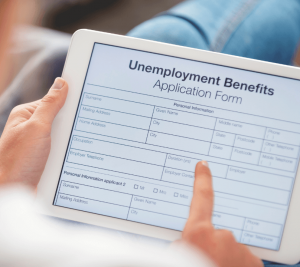By Kara Sherrer
Employees are one of the most essential classes of stakeholders in any business. Not only are they critical to the company’s operations, but they also bear the risk of potential unemployment, potentially relying on unemployment benefits during such times. Interestingly, much research to date has largely ignored the relationships between employees’ contracts design and their employers’ debt contracts with the firm’s external creditors; this is surprising, as a firm is usually viewed as the nexus of both explicit and implicit contractual relationships between its different stakeholders.
Closing the Research Gap

Daniel Cohen, Frances Hampton Currey Chair, Professor of Accounting
Professor of Accounting Daniel Cohen seeks to help rectify the gap in the literature with his latest paper, Unemployment Risk and Debt Contract Design. The study is co-authored by Cohen, the Frances Hampton Currey Chair of Accounting at Vanderbilt Business, Nir Yehuda from the University of Delaware, Christopher S. Armstrong from Stanford University, and Xiaolu Zhou from The Chinese University of Hong Kong.
What is a debt contract?
Raising financial capital is an essential aspect of the operation of any business. In the U.S., debt, such as bonds, syndicated loans, or any other types of loans, are a crucial source of capital. When a firm decides to obtain debt capital, it will sign and enter a contractual agreement with its creditors to address potential conflicts (usually referred to in the accounting, economics, and finance literature as agency conflicts). These contractual arrangements often include details on the amount borrowed, the interest rate charged, the timing of payments and maturity of the loan, and specific covenants that might restrict the subsequent actions and behavior the borrowing firm can undertake once receiving debt capital. Creditors demand assurances that the firm’s managers are committed to fulfilling their agreements. As such, managers agree to include specific accounting-based covenants in these contracts that will limit and prohibit the managers from taking certain actions that might benefit shareholders at the expense of the creditors.
The Risk of Unemployment
Firms’ contractual relationships with their employees include not only explicit employment contracts, but also implicit promises, such as job security and the potential for promotion. Employees’ exposure to unemployment risk is costly and affects their incentives to work hard and invest in their current workplace. Unemployment risk can diminish firms’ ability and incentives to honor their implicit employment contracts. Faced with corporate risk-taking behavior, non-executive employees, therefore, might demand substantially higher wages, as this behavior increases their uncertainty and could lead to layoffs. To minimize this wage premium, managers may adopt conservative financial and operating policies that align more with creditors’ and less with shareholders’ preferences.
The researchers examine the relationship between the design of debt contracts and unemployment insurance (UI) benefits, which provide an arguable change in employees’ collective tolerance for risk. As such, changes in state-wide UI benefits are viewed as a source of variation in the wage premium employees demand from their employers. An increase in UI benefits also reduces risks for employees because they have the security of knowing they will receive financial support, even if they don’t get the same generous severance package that an executive might. In other words, it reduces their cost of unemployment if terminated without cause. Indeed, it is well-documented by prior researchers that larger state UI benefits reduce the cost of unemployment from the employee’s point of view, which, in turn, allows managers and firms to take more risks and engage in riskier operations.
“Our study is important as rank-and-file employees are a significant and important stakeholder within a public firm,” Cohen explained. “There is a large literature spanning numerous fields such as accounting, finance, and labor economics that examine the significant costs employees bear during unemployment. As such, unemployment risk is a first-order concern employees care about.”
High Operating Risk and Debt Contracts, Study Details
 The researchers obtained data from 1993-2012 on unemployment insurance benefits, stock returns, financial reporting, and private debt agreements. They tracked state-wide changes to unemployment insurance programs and analyzed financial information to determine how companies headquartered in those states performed over time.
The researchers obtained data from 1993-2012 on unemployment insurance benefits, stock returns, financial reporting, and private debt agreements. They tracked state-wide changes to unemployment insurance programs and analyzed financial information to determine how companies headquartered in those states performed over time.
Cohen and his co-authors found that more generous unemployment insurance benefits were associated with a higher operating risk undertaken by the managers/firms. Higher UI benefits were associated with a higher operating leverage and a significant increase in operating cash flow volatility, increasing the likelihood of negative outcomes. However, firms with a higher operating leverage were also more likely to introduce new products and improve existing ones.
The researchers also looked at how the structure of debt contracts changed after state-wide increases in unemployment benefits. They found that new loans initiated after these increases tended to contain more performance-based covenants than capital covenants ones. Capital covenants rely on balance sheet accounting numbers, which are less sensitive to the borrowers’ performance, whereas performance covenants rely on income statement accounting numbers. In other words, performance covenants are more likely to be violated when a company performs poorly compared to capital covenants. This notion suggests that debt contracts were altered, accounting for a company’s likelihood of negative financial outcomes following a state-wide increase in UI benefits. Overall, the researchers show how an important source of corporate risk largely borne by non-executive stakeholders affects the design of the firms’ debt contracts with its external capital providers.
“We extend this literature by arguing and showing that firms’ employment contracts should influence not only the amount of debt but also the attributes of this debt, including the specific design of debt contracts,” Cohen said.
The paper, Unemployment Risk and Debt Contract Design, is forthcoming in the November 2023 edition of The Accounting Review.